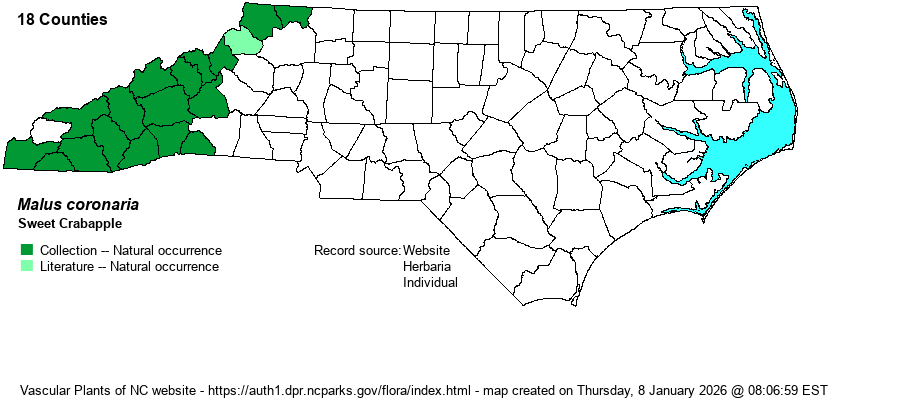| Author | (L.) P. Miller | |
| Distribution | Essentially the Mountains only, occurring in most counties in the province. A few scattered records from the eastern Piedmont and Coastal Plain likely refer to escapes or misidentifications, though Weakley (2018) considers it native in the Piedmont. None of these are included on the map, as scattered checks of SERNEC specimens seem to be misidentifications.
This is the northern counterpart of Malus angustifolia, being present from NY, extreme southern ON, and the northern Great Lakes states, south to GA and AL.
| |
| Abundance | Infrequent to fairly common, if not locally frequent, but seldom common – in the Mountains. Extremely rare away from the Mountains and of uncertain provenance. | |
| Habitat | As with the previous species, it is found mainly in mesic soils of hardwood forest margins, fencerows, and thickets. It is rarely found in wetlands such as bottomlands, nor is it normally found in forest interiors. |
| Phenology | Because it occurs at mostly middle elevations, it does not bloom until May; it fruits in September and October. | |
| Identification | This is a small deciduous tree, reaching 15-20 feet tall, often growing in thickets by way of root sprouts. The leaves are wider and more clearly toothed than are those of Southern Crabapple, being ovate to ovate-lanceolate; they can look a bit triangular in shape and thus resemble leaves of many hawthorns (Crataegus spp.). The large pink flowers are showy when in full bloom and should readily identify the species at a distance, especially as hawthorns have white flowers and Southern Crabapple has differently-shaped leaves. | |
| Taxonomic Comments | It has often been named as Pyrus coronaria. There are several other much older names, but no longer in normal usage. A synonym is M. glaucescens.
| |
| Other Common Name(s) | Wild Crabapple, American Crabapple, Garland Crabapple. Many references use “crab apple” instead of “crabapple”. | |
| State Rank | S2S3 | |
| Global Rank | G5 | |
| State Status | | |
| US Status | | |
| USACE-agcp | | |
| USACE-emp | | |

